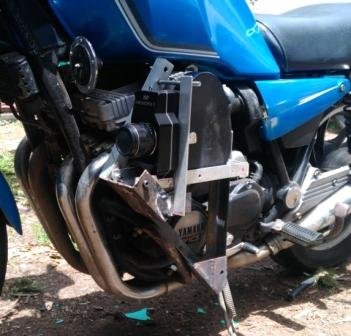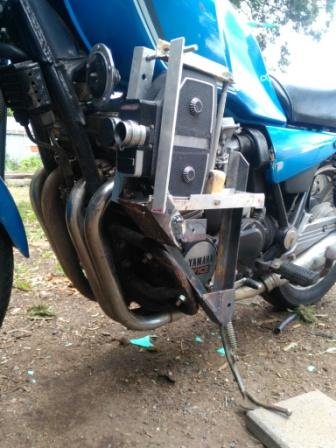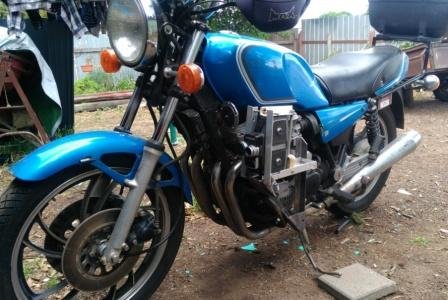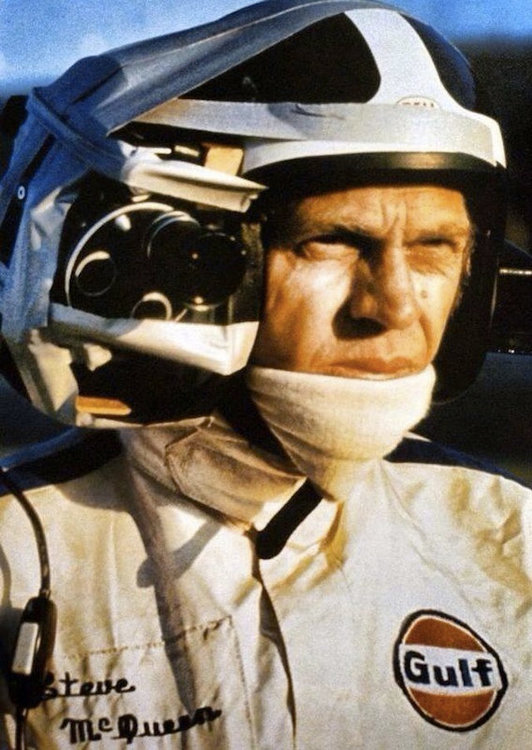-
Posts
301 -
Joined
-
Last visited
Posts posted by Gareth Blackstock
-
-
Gday, not sure about reversal not being done, I have been shooting expired B&W neg, and artist film workshop in Melbourne process it as reversal, easier for me at the moment. They do good work, and offer transfers.
-
G'day,
Thanks for the comments, food for thought. Regarding heat from the engine, I will be adding a plate of metal between the mount and engine, it is summer here at the moment with temperatures expecting be climb to around 35 to 40 degrees Centigrade this year.
I am adding rubber mounting and foam tape to help with vibration. I shall soon see though.
cheers, Gareth
-
Hello,
i have attached some images of a 16mm motorbike camera mount i am working on. i will be using a Bell & Howell 240 with a 20mm lens and a K3 with a Takumar 28mm. i have a project lined up, and getting some good riding footage will be a priority.
i designed the mount to universally fit more than one camera, has an adjustable tilt, and can be raised or lowered, depending on how much leaning there will be. The mount is attached to a standard motorcycle crash guard.
Over the next week i will be fine tuning it before running some film through it see how she comes out. I am curious how vibration might affect the image, and thats one reason why i am posting this is to see if others have developed mounts, and how they got around vibration.
i did a search around the net and saw no D.I.Y mounts, which I thought odd considering that many older camera operators often build what they cannot buy or steal.
Years ago I made a bonnet mount for a short, and while in use it jiggled abit, but curiously the footage showed no real jiggle. so I figured that vertical vibration may be absorbed by the film traveling vertically through the gate, whereas horizontal vibration would be easily spotted?
Hopefully I get some sweet footage!
And i won't be replicating the early helmet cam either, especially not with a K3
-
Gday,
I used to have one of these cameras a few years back, great to use with no issues. Always put the batteries in the right order inside the battery pack, putting them in wrong could melt parts of the pack. I think the switch you might be referring to moves the 85 filter out of the film path. Normally a common screw can be used, source one from a hardware store for a few cents.
I always thought the Sankyos were a very under rated camera, very reliable in my experience.
Happy shooting
-
Gday,
Perhaps have a look at www.nakanocam.com using google translate, he has rectified a similar prob with an 814. Chances are it is similar layout.
Cheers, gareth
-
Hello,
The other week I managed to buy a Bell & Howell 240 electric eye for around $45, the seller stated it did not work. I had been keen on getting one for awhile as most people seemed pretty happy with them.
When it arrived, I was surprised that it came with the extra telephoto, incl. the viewfinder mini lens, and all the caps. The camera seemed in excellent condition, but the spring was definitely over wound. I had never unstuck a jammed one before, so I took lots of pics and added them to my site. I won't bother with getting batteries for the electric eye, I'll just use a light meter.
Happily I fixed the camera up, had some spares handy, so now I have a great camera for hardly any money, and if people are interested, I did a little D.I.Y section. I should be shooting with it soon, I am pretty keen to see the footage. Awesome camera, really nicely built too.
http://canon-s8-repair.yolasite.com/bell-and-howell-240ee.php
Hope it's handy, Cheers.
-
I didn't say welding was easy, just cheap. Cheaper than learning about cameras to a highly skilled level. With welding, if you can run a good bead, you'll never starve.
How many highly skilled camera operators can say the same? How many people in the industry, behind camera can say the same?
-
Have a back up skill that earns decent money, like welding. Cheap to learn, and a skilled welder will find work anywhere in the world.
-
Well I reckon if the spring motor runs at speeds you can discern, without fluctuating, I would hazard a guess that all is well. I think the only damage that could occur would maybe be to the spring? I'm sure some one with more knowledge would pipe up soon.
Apparently the cameras are pretty hardy, and when desperate they can be used as weapons, and still keep filming.
Apparently an early soviet requirement for war time purposes....
-
I would guess that if you run it at 18 or 12fps, it should tell you immediately if there's a problem?
Gareth
-
Keep researching, yashica, Elmo, and sankyo produced great cameras, but research which ones accept modern super8. What do you want from a camera? Canons are great, but unless you spend big, you won't know which of its many functions still work.
The 814 is cheaper than the 1014, difference? Longer zoom. Don't zoom, walk closer...
The cream cameras of most brands offered more features, a top of the line Elmo may offer same functions of the canon for quarter the price.
Good luck....
-
G'day,
Well after shooting around 400 feet of film with the Pentaflex, I have to say I am pretty impressed. It was not as noisy as I thought it would be, and while it is pretty damn heavy to lug around, I found it pretty easy to use. Sadly my projector has packed it in so I cannot upload some poorly transferred footage. I am shooting some expired colour soon, and I will get around 400ft of film transferred and uploaded.
Initially I thought I would have issues with loading film into the cassettes inside a change bag, but I came up with a way to do it without all the stress.
I posted the info here:
http://www.cinematography.com/index.php?showtopic=74577
Mostly I thought a good reason to find a better way was that when ever I searched for info on the camera, I came across lots of posts complaining of jamming film, noisy cassettes, torn film, or similar. So I figured a way to make sure the film path is just right, every time. That's reassurance I like. So needless to say, the film ran sweetly, no jams.
So far so good, after giving the camera a gentle lube, and re-adjustment of a few things, I reckon I have a reliable easy to use camera. The build quality is pretty good too, very solid, and the machining is very nice work. The only down side I can spot so far are the Bakelite gears inside the camera which would make it prone to getting stripped if someone tried to dry run the camera by hand without disengaging the gear lock.
Anyway, I hoped by putting this up on the board, future potential users might find a bit of positive info and give the camera a go.
Cheers, Gareth
For details of camera lube:
http://canon-s8-repair.yolasite.com/pentaflex-ak16.php
-
Hello,
Yes, the Pentaflex uses daylight spools, and one can load in subdued light, however, I prefer to change in the bag, and also "general opinion" among film users appears to recommend changing in the bag. Also, when I got my K3, I practiced loading film, like you suggest, and yes, I can do it in the bag entirely, it just takes me quite a few minutes to be happy with the load.
However, the Pentaflex film path appears to me, an amateur, to be a hellava lot more complex than the K3. I just loaded one of my film cassettes, and from start to finish, the whole process took me 6 minutes. Considering I have not practiced loading the cassette, I reckon thats pretty good.
Cheers, Gareth
-
A while ago I bought a Pentaflex kit, and while I have not had the chance to use it yet, life getting the way, etc. It struck me that loading the film cassette in a change bag was going to be difficult. Now unlike a professional, I don't get to shoot often, and becoming skilled at loading film in a change bag could take a long time with lots of mistakes, tight loops, not sitting on the gear, etc. And the more I looked at the Pentaflex's film cassette film path, the more worried I became.
So I thought up a way that I could thread the Pentaflex's film cassette in light, and also ensure that film such as negative is not exposed to stray light. I am not sure if it's old news, or been done before heaps of times, but I thought I will save me alot of time, and perhaps assist other film loaders who don't get a chance to load frequently and become skilled.
1. cut a small slit into a spare 100ft film cart, just under the lid.
2. place into change bag, place film inside, pull out enough film to thread camera through slit
3. close film cart lid, place tape over film and slit to ensure light proof and remove from bag.
4. in normal light, go about threading the film cassette, wind onto an empty reel. Leave film cart sitting ontop.
5. place everything back in the change bag, remove the unexposed film from the cart, place and secure into cassette, place lid on, and secure.
Below is a link to some pics:
https://goo.gl/photos/GfFWHTwRapWKLv6c8
I would be interested in thoughts....
cheers, Gareth
-
I recently came across this:
http://www.ebay.com.au/itm/super-8-film-/112383459627?hash=item1a2a93812b:g:QjMAAOSwnF9Y6wTf
18 carts of Kodachrome sound film! I would be interested to see how much they go for...
cheers, Gareth
-
G'day,
I have a Pentovar 16 combo coming in the mail, and heaps of old Ektachrome reversal to shoot, cannot wait to shoot. When I come down to Melbourne I will drop in with the camera, hopefully the lens is ion good condition.
Jeff, I had a look at your footage, and it looks pretty sweet. How was the footage before any post work was done on it? Any issues with the film cassettes?
cheers, Gareth
-
Thanks,
I have also added another one on the Pentaflex with more details on accessories, colour pictures, and a little more information:
http://www.mediafire.com/file/ltglpn63c3tlh47/Pentaflex+AK16+User+Manual+English+Translation.pdf
Cheers, Gareth
-
I think offering an online version is great. Without the costs of printing and shipping, you may even get more articles and info. Many people already read magazines online, and it has become much easier to do for people of different tech capabilities, a web portal is the next best thing to s paper mag.
Good luck getting it started.
-
Hello,
After recently buying a Pentaflex, I searched around for an English version of the user manual and found nothing. So I decided to translate one an upload a copy. I have uploaded a copy for download on this site:
http://www.mediafire.com/file/glwq8eyin8h7w27/Pentaflex+AK16+Operation+Manual.pdf
When you click on the link, a window will open. On the "download now" button, right click with your mouse and select "save link as.." It is a safe download, no junk or spam. On my job I do some night shifts, so a few hours work helped pass the time.
I updated my site with pictures and info of the basic lube and adjustment of my Pentaflex.
http://canon-s8-repair.yolasite.com/pentaflex-ak16.php
I hope the site and manual help out future Pentaflex buyers and users.
cheers, Gareth
-
You can have a lot of fun with colour filters and B7W film, below is one such website with heaps of samples, look halfway down the page to see how different coloured filter affect the picture taken.
I think regarding b&w reversal people used to suggest under exposing by a stop, helps with shades, keeps blacks "blacker", and I think it's easier to correct on a computer under exposed compared to over exposed film. I think....
Do a search through the forum, there's heaps of more accurate info in here somewhere..
cheers, Gareth
-
G'day,
Well I bought one, I had been watching a nice looking Pentovar 16 for only $130 with free postage. I figured that a wise choice considering I am not sure if me and the camera will get on yet. I was negotiating to buy 2 Zeiss prime lenses, but either my Russian is rather dodgy, or he was giving me the run around. If I end up getting on well with the camera I will be buying a nice set of prime lenses.
The camera I bought is a Pentaflex AK16. In quite nice condition, just missing a lens. From the research I did, they seem a hard camera to love, but considering the cost to buy, $170 and the wide options on nice lenses, I thought "what the hell". I already love my K-3 and most reckon thats a hard camera to love...
Cheers, Gareth
-
Thanks for the advice guys, I think I will steer definitely towards getting some prime lenses, or at least not buy a big prime lens thinking it's a zoom. (face palm) It looks like the most common available for my camera are 12.5mm, and 25mm. I will have to wait until a 50mm comes up on ebay or similar. I am keen to run some film through it...
cheers, Gareth
-
G'day,
I had a quick search around and did not come up with much good info. Basically I wanted to guage opinion on what was best lens choice for my 16mm camera.
I can buy a Carl Zeiss TRIOTAR 4/135 zoom for around $200, or I can buy 2 lenses, Carl Zeiss Jena Flektogon 12.5mm and 25mm for around the same money.
From my reading, primes appear to be the choice for quality and image, and while zooms are catching up, they are best for flexibilty. Although I am leaning towards 2 primes instead of the zoom, I have a suspicion that still photographers can easily view the differences between lenses, however, will an old 16mm camera, shooting old stock be the best way of seeing the differences between prime and zoom lenses? Am I wasting money on good glass when perhaps I would not not notice it, and would I benefit more from a moderately priced modern zoom?
Perhaps I can be educated with some links?
cheers, Gareth
-
Hello,
Thanks for the constructive replies. While you are all on the button, and your thoughts make sense, I still struggle with letting a camera pass me by when just a few years ago they were beyond my reach. But, as my wife says, "you're a film maker, not a collector" Now if I could only stop life interfering with the creative process...
And I guess once I finish off my old double perf stock, I won't want to shoot 4/3 again... I considered getting a Bolex years ago, but opted for the K-3 for a few reasons, they are heaps cheaper, simple enough that I can repair them, cheap to purchase quality glass, cheap and easy to convert to Super16 and sturdy. And I reckon I would be better spending top dollar on good lenses than camera bodies.
Evan, I have not come across your pull down claw problem with my own cameras. My site does not go that deep into the "guts" of the camera. I have a link to a Japanese bloke who does go that deep: http://canon-s8-repair.yolasite.com/advanced-camera-repair.php
Be careful if you do decide to dismantle that far, as you will be removing alot of parts just to get to the claw I think...
cheers, Gareth








Continuous scratch along non emulsion side of Krasnogorsk 3
in Film Stocks & Processing
Posted
Simon, I think you are being a little heavy handed in the way you imply Eastern European technology as being archaic. I think that what you say is quite broad and fails to take into account a huge amount of variables. For a time, Eastern European technology was highly respected, and in some industries, is still considered the "standard" to achieve.
I asked a cinematographer years ago for advice on buying a camera, he basically stated that considering the mechanisms that advance the film have remained essentially the same since photography began, he said focus on the really important stuff, the 6 inches in front of the film, and the 10 inches looking through the view finder, ie: pick a good lens and learn your craft. Good advice, I'm still trying to get there... anyway I figure if you screwed a modern lens onto a 1907 handcrank, and shot with some nice Kodak film, you just might get the same footage as a modern Arri, etc. Perhaps I am being too broad, but you get the picture?
And what you say about borrowing technology, well companies have been adopting, adapting, stealing, copying etc off each other for centuries, it's considered standard practice. One story every motorcyclist should know, Ernst Degner, defected from Eastern Europe in the 60's, and with stolen technology enabled Suzuki to rule supreme of the 2 stroke racing world. In other words, the West has been pilfering technology from the East just as much as they are accused of taking from the west. And, suggesting that Eastern Europeans simply copied technology, flies in the face of so many unique and advanced designs in many industries.
I am of the opinion that if you find a camera, clean it, do what you can to get it running, shoot some film, and learn about it enough that you can fix or adapt, and modify the camera to suit your needs. If it scratches, smooth out the burr, a light leak? strap on some gaffer tape, thats what it is for, if the camera is too heavy, get someone else to carry it, if it squeaks, lube the bugger, if you can afford it, get it serviced, if you get chased while filming, throw the bloody camera at them, if it's a K3, go back and pick it up, it'll still work. Try that with an Arriflex.
While I imagine this board has multitudes of industry pro's who make money from film, who can get their equipment claimed as a tax write off, who probably get free stuff, and perhaps smirk at the grubby little film makers messing around with obscure cameras and expired film, spare a thought that the very best camera operators, directors, gaffers, editors, cinematographers, et all, from any film industries "golden period", were filming in a time where skills, initiative, imagination, and daring were more important than the name plate riveted to a box on a tripod.
IMHO. :rolleyes: